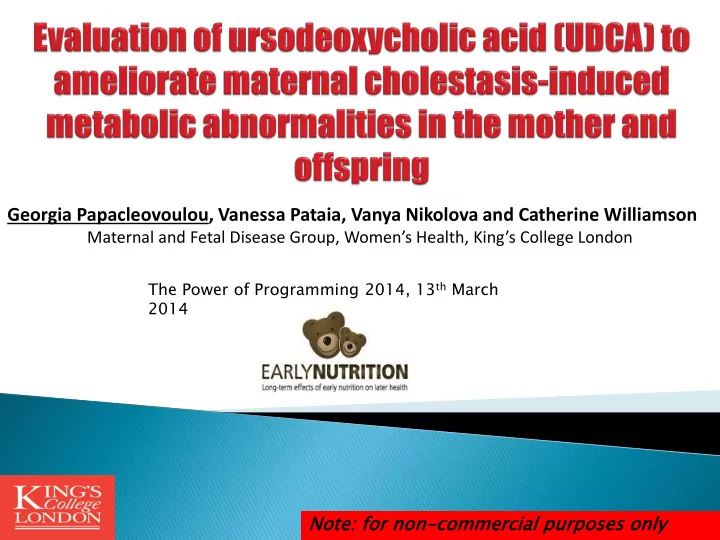

Georgia Papacleovoulou, Vanessa Pataia, Vanya Nikolova and Catherine Williamson Maternal and Fetal Disease Group, Women’s Health, King’s College London The Power of Programming 2014, 13 th March 2014 Note: : for non non-com ommerci mercial al purposes only
A liver-specific disease of pregnancy Affects both the mother and the fetus Mother: Raised serum bile acids (BA) i) Dyslipidaemia ii) Fetus Impaired transfer of bile acids from the fetus to the i) mother Accumulation of bile acids in the fetal circulation ii)
Fxr BA Fxr BA Uptake BA Secretion BA Shp BA Oatp1a1, b2, a4 Bsep Cyp7a1 Cholesterol BA
UDCA is used to treat cholestatic liver diseases and is the most common treatment for ICP Experimental data suggest that UDCA protects the liver from ◦ BA cytotoxicity ◦ BA-induced apoptosis UDCA promotes hepatic excretion of BA UDCA restores the impaired BA gradient across the placenta Beuer ers; 3:318-28 28 Nat Clin Pract Gastroen oenter terol ol Hepatol ol, , 2006 2006 Geenes es et al. ; 9(1):e838 83828 28 Plos One , 2014
ICP and metabolic programming in the offspring Parameter Control ICP Male offspring maternal BMI (kg/m 2 ) 22.20 ± 0.05 22.19 ± 0.7 placenta weight (g) 655.40 ± 2.25 677.60 ± 30.3 BMI (kg/ g/m 2 ) 21.07 ± 0.06 23.63 ± 1.2* birth weight (g) 3600 ± 1.04 3600 ± 113.8 hip girth (cm) 91.6 ± 0.14 95.5 ± 2.44 waist girth (cm) 75.6 ± 0.16 74.77 ± 4.31 insul in ulin in (mU mU/L) 10.76 ± 0.13 23.60 ± 7.5* BMI (kg/m 2 ) 21.07 ± 0.06 23.63 ± 1.2* insulin (mU/L) 10.76 ± 0.13 23.60 ± 7.5* apolipoprotein B (mmol/L) 0.65 ± 0.003 0.69 ± 0.03 HDL-chol (mmol/L) 1.29 ± 0.006 1.34 ± 0.08 LDL-chol (mmol/L) 2.13 ± 0.01 2.30 ± 0.16 Female offspring maternal BMI (kg/m 2 ) 22.30 ± 0.05 22.50 ± 1.23 placenta weight (g) 645 ± 2.26 649 ± 29.9 hip girth (cm) 92.9 ± 0.13 96.7 ± 1.4* birth weight (g) 3500 ± 12.2 3400 ± 104.9 hip girth (cm) 92.9 ± 0.13 96.7 ± 1.4* waist girth (cm) 71.8 ± 0.15 77.5 ± 2.3* waist girth (cm) 71.8 ± 0.15 77.5 ± 2.3* BMI (kg/m 2 ) 21.17 ± 0.05 22.44 ± 0.7 males: insulin (mU/L) 10.64 ± 0.11 10.08 ± 0.8 control n=4034; ICP n=27 apolipoprotein B (mmol/L) 0.68 ± 0.16 0.71 ± 0.03 females: HDL-chol (mmol/L) 1.49 ± 0.05 1.36 ± 0.04* HDL-chol (mmol/L) 1.49 ± 0.05 1.36 ± 0.04* control n=3774; ICP n=18 LDL-chol (mmol/L) 2.30 ± 0.01 2.36 ± 0.11 *p≤0.05 Papacleo eovou voulou ou et al. ;123(7) 7):3 :3172 172-81 81 J J Clin Invest est , 2013
F emale offspring exposed to high BA in utero develop metabolic disease Papacleo eovou voulou ou et al. ;123(7) 7):3 :3172 172-81 81 J J Clin Invest est , 2013
Cholestatic pregnancy causes dyslipidaemia in the fetoplacental unit Mouse placen centa Mouse placen centa Human placen centa Human umbilica lical l cord d serum um Papacleo eovo voulou ou et al. ;123(7) 7):3 :3172 172-81 81 J J Clin Invest est , 2013
Hypothesis UDCA can be used as an intervention in ICP to correct BA- related fetoplacental dyslipidaemia and prevent metabolic disease in the offspring
Administration of UDCA in cholestatic pregnancy 0.5% CA feeding 0.5% UDCA feeding Maternal liver, placenta, fetal liver Maternal and fetal serum Gene expression of BA and lipid metabolic genes measurements BA Cholesterol FA homeostasis homeostasis homeostasis
E ffect of UDCA on BA homeostasis in the maternal liver Cyp7 p7a1 Cyp7 p7a1 a1 ion ive expression # Relative Fxr * BA Fxr NC CA BA CA+UDCA Shp Diet Bsep Cyp7a1 Bsep 6 Cholesterol BA ion ion ive expressio * essio 4 ive expres # Relative Relative 2 0 NC CA CA+UDCA Diet
E ffect of UDCA on BA transporters in the placenta Mrp2 3 Oatp1 p1a1 a1 3 # ion ion ession # ession ive expres 2 ive expres 2 * Relative Relative 1 1 0 0 NC CA CA+UDCA NC CA CA+UDCA Diet Diet Oatp1 p1a4 a4 1,5 Oatp1 p1b2 b2 12 # ion ion ession ession # 10 1 ive expres ive expres 8 6 Relative Relative 0,5 4 * 2 0 0 NC CA CA+UDCA NC CA CA+UDCA Diet Diet Placenta Mrp2 Fetal Maternal BA circulation circulation Oatp1a1, b2, a4 Oatp1a1, b2, a4
E ffect of UDCA in lipid biosynthesis in the fetal liver Hmgcr Fas * 5 3 ion ession * ion ession 4 # ive expres ive expres 2 3 2 Relative Relative 1 1 0 0 NC CA CA+UDCA NC CA CA+UDCA Diet Diet C FA Hmgcr Fas
Summary 0.5% CA feeding 0.5% UDCA feeding Fxr BA Shp C FA Bsep BA Cyp7a1 Hmgcr C BA BA BA Fas Mrp2 BA Oatp1a1, b2, a4 Maternal liver Fetal liver Oatp1a1, b2, a4 Placenta Maternal Fetal circulation circulation
Ongoing work Biochemical measurements to study the effect of UDCA on bile acids and lipids in the mother and the fetus Study the effects of UDCA on the lipid homeostasis pathways in placenta and fetal liver To address the effects of administration of UDCA in pregnancy on the long-term health of the offspring in mice and humans
Acknowledgements Professor Catherine Williamson Vanessa Pataia Vanya Nikolova Maternal and Fetal Disease group
Recommend
More recommend